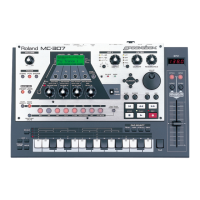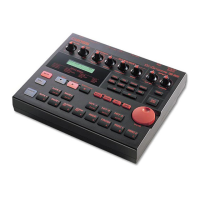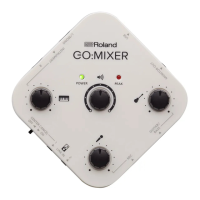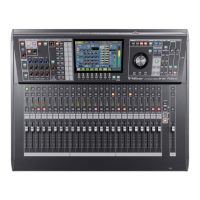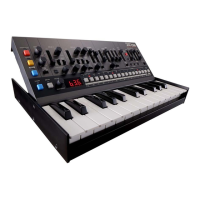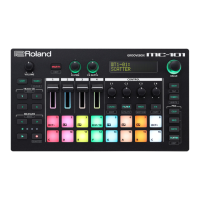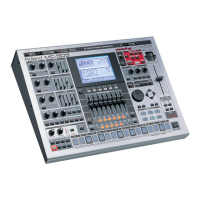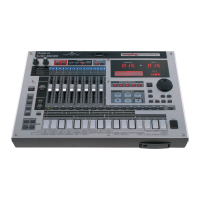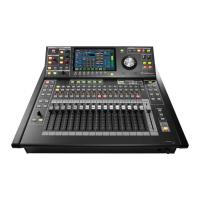28
Chapter 3. About the D-FIELD
Arpeggio settings
Arpeggio Styles
When you wish to make arpeggiator settings, you will first select an Arpeggio Style. When you select a style, optimal values will
be set for the four parameters “Motif,” “Beat Pattern,” “Shuffle Rate,” and “Accent Rate.” You can adjust parameters such as
Accent Rage and Octave Range to modify the pattern to your taste.
MOTIF
Specifies the order in which the notes of the chord will be sounded.
* The values which can be set will depend on the currently selected arpeggio style. For details on the possible values for each style, refer to
“Table of STYLE/MOTIF/BEAT PATTERN” on next page.
STYLE Explanation
1/4 The rhythm will be divided in quarter notes.
1/6 The rhythm will be divided in quarter note triplets.
1/8 The rhythm will be divided in eighth notes.
1/12 The rhythm will be divided in eighth note triplets.
1/16 The rhythm will be divided in 16th notes.
1/32 The rhythm will be divided in 32nd notes.
PORTAMENTO A, B A style using the portamento effect.
GLISSANDO A glissando style.
SEQUENCE A–D Styles for sequenced patterns.
ECHO An echo-like style.
BASS 1–4 Styles appropriate for bass playing.
RHYTHM GUITAR 1–5 Guitar strumming styles.
3 FINGER Three-finger guitar style.
STRUMMING GUITAR A style simulating a guitar chord strummed upward (downward).
PIANO BACKING, CLAVI CHORD Styles for keyboard instrument backing.
WALTZ, SWING WALTZ Styles in triple meter.
REGGAE A reggae-type style.
PERCUSSION A style suitable for percussive instrument sounds.
HARP The playing style of a harp.
SHAMISEN The playing style of a Shamisen.
BOUND BALL A style suggestive of a bouncing ball.
RANDOM A style in which the notes sound in random order.
BOSSA NOVA Bossa nova guitar strumming style. Can also be used for Samba by making the BPM faster.
SALSA Typical salsa style.
MAMBO Typical mambo style.
LATIN PERCUSSION
A rhythm style with Latin percussion instruments such as Claves, Cowbell, Clap, Bongo, Conga, Agogo etc.
SAMBA Typical samba style. Use for rhythm patterns or bass lines.
TANGO Typical tango rhythm style.
HOUSE A style for house piano backing.
LIMITLESS The settings of all parameters can be freely combined without restriction.
USER STYLE 1–10 Arpeggio settings can be modified and saved in one of these user styles.
MOTIF Description
SINGLE UP Notes will be sounded individually, beginning from low to high.
SINGLE DOWN Notes will be sounded individually, beginning from high to low.
SINGLE UP&DW Notes will be sounded individually, from low to high, and then back down from high to low.
SINGLE RANDOM Notes will be sounded individually, in random order.
DUAL UP Notes will be sounded two at a time, beginning from low to high.
DUAL DOWN Notes will be sounded two at a time, beginning from high to low.
DUAL UP&DW Notes will be sounded two at a time, from low to high, and then back down from high to low.
DUAL RANDOM Notes will be sounded two at a time, in random order.
TRIPLE UP Notes will sound three at a time, from low to high.
TRIPLE DOWN Notes will sound three at a time, from high to low.
TRIPLE UP&DOWN Notes will sound three at a time, from low to high and then back down from high to low.
TRIPLE RANDOM Notes will sound three at a time, in random order.
NOTE ORDER Notes you press will be sounded in the order in which you pressed them. By pressing the notes in the appropriate or-
der you can produce melody lines. Up to 32 notes will be remembered.
* This is valid only when playing arpeggios from an external MIDI device.
GLISSANDO Each chromatic step between the highest and lowest notes will sound in succession, repeating upward and downward.
Press only the lowest and the highest notes.
CHORD All notes will sound simultaneously.
BASS+CHORD 1–5 The lowest of the notes you play will sound, and the remaining notes will sound as a chord.
BASS+UP 1–8 The lowest of the notes you play will sound, and the remaining notes will be arpeggiated.
BASS+RND 1–3 The lowest of the notes you play will sound, and the remaining notes will sound in random order.
TOP+UP 1–6 The highest of the notes you play will sound, and the remaining notes will be arpeggiated.
BASS+UP+TOP The highest and the lowest of the notes you play will sound, and the remaining notes will be arpeggiated.
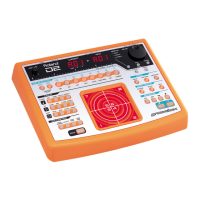
